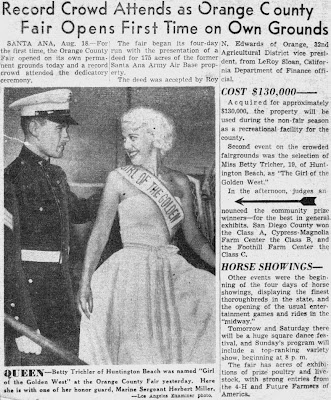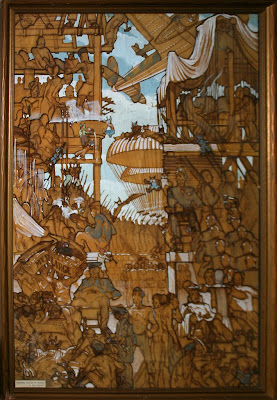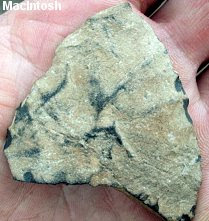
A number of postal employees are spreading the word that
Huntington Beach's
Main Street Post Office (1935) at 316 Olive Ave will close in October. Here's some of the traffic from the
HBTalk listserv over the past couple days:
.Marinka Horack wrote: "...The postal staff ...also said that the...building would be sold to the city. The downtown post office is a beautiful historic building and it would be a terrible loss if it were to be torn down... Does the building have historic status protection?..."
. Chris Epting wrote: "That's an interesting building--a
WPA project that actually has a sister building, exact same design, in
Santa Paula, CA. Any official announcement about the closure yet?"
.
Mary Adams Urashima wrote: "The California '
New Deal' projects marked their
75-year anniversary in 2008, and they are still trying to identify all sites. The only one noted for Huntington Beach so far is the recreation building. Chris, do you know what year the post office was constructed? I believe the federal government must post a public notice for the sale of surplus property, subject to bids. However, there is a clause that allows for negotiated disposal of surplus property to "tax-supported agencies"-which would be the City. See section 203 of the
Federal Property & Administrative Services Act (update 2000).
."With the present economic situation and the federal government trying to cut costs, the City might negotiate a great deal on a historic federal property. I would think a WPA building could easily qualify as a historic building, definitely worth preservation through grants or redevelopment funds."
.John Earl wrote: "I wonder if there's a way to prevent this. Closing the downtown post office will create a great inconvenience for many who live in the downtown area."
.
Chris Jepsen wrote: "With a couple exceptions, the City of Huntington Beach has a poor track record with historical preservation. They've made noises in recent years about improving that reputation, but who knows if that will happen. In short, if you want to save the building, start *now*.
.
"The Post Office was built in 1935. It was designed by
Louis A. Simon and built by
L.F. Dow of
Los Angeles. I believe it was built as a
PWA or
WPA project. Simon also designed the
U.S. Federal Courthouse in Downtown L.A., the
Canoga Park Post Office (1938), the
Whittier Post Office (1935) and others.
.
"I'm very sorry to hear it's closing, because -- from a resident's perspective -- it was one of the last functional bits of Downtown."
.
[Photo of the building's dedication appears below.]
 Mary Adams Urashima wrote:
Mary Adams Urashima wrote: "...Louis A. Simon designed many of the depression-era post offices and other public buildings that are now listed on the
National Register of Historic Places. He also designed the
Internal Revenue Building in
Washington, D.C., but let's not hold that against him. : )
."Here's the info from the
Depew, NY, post office historic register nomination document (it's not as old as HB's downtown post office, but is listed):
"Louis A. Simon served as Supervising Architect from 1933 until 1939, but he had
been associated with the office from 1896. Simon was Superintendent of Architects in the office between 1905 and 1933. From 1915 to 1933...Simon was responsible for the direction of much of the design work. Most of Simon's buildings were designed in the Colonial Revival style and, on occasion, in a restrained or more stylized classically derived style. The use of a standard pattern for these buildings reflects the increasing simplicity of design and standardization of form which are characteristic of post offices of this period, the most prolific era of post office construction in the nation's history.
As early as 1930, the federal government had implemented a massive post office construction program to help offset widespread unemployment caused by the Great Depression. By the end of the decade, however, with the onset of World War II, Congress postponed indefinitely the construction of most post offices not yet under contract."
John Scott wrote: "[The town of
Kearney,]
Nebraska... was faced with a similar problem with their post office which I would guess was built about the same time as ours... Several retired professors... recognized the treasure that the city had in this old building and decided it must be preserved. ...This Post Office is now an
art museum..."
.
Chris Jepsen wrote: "Huntington Beach needs a non-profit preservation group like the ones in
Anaheim and
Santa Ana. The group's primary goals would be to educate the public and government about our historical resources and to work toward preserving those resources. They could also promote local adoption of the
Mills Act. And occasionally - and especially in the beginning - they might need to hire lawyers to make sure the city is complying with the historical aspects of
CEQA.
.
"We did a
program on historical preservation for the City at the Art Center early this year. Unfortunately, only a few people saw it because it wasn't promoted. I'd be happy to give that talk again if there's an audience for it. (I'd need a bit of advance notice, since I'd want to involve at least one additional speaker.)
.
"Another point: If H.B. is so dedicated to tourism, we should recognize the enormous economic value of 'Heritage Tourism' and put it to work for us. That means playing up our historic resources rather than bulldozing or remodeling them."
.
Epilogue: The the wake of these emails, I'm now hearing that the City and some postal employees deny knowledge of the situation, while others are verifying that the building is going to close. As things get clearer, I'll keep you posted.
 There was a very nice and very well-attended funeral service for J.J. Friis this morning. At the reception afterwards, there was a table full of photos of him, including this older one (above) with his parents. Since I don't know how long the Register will keep J.J.'s obituary on their website, I'm posting it below:
There was a very nice and very well-attended funeral service for J.J. Friis this morning. At the reception afterwards, there was a table full of photos of him, including this older one (above) with his parents. Since I don't know how long the Register will keep J.J.'s obituary on their website, I'm posting it below:



























.jpg)















 Recent Register articles have included historical
Recent Register articles have included historical 



